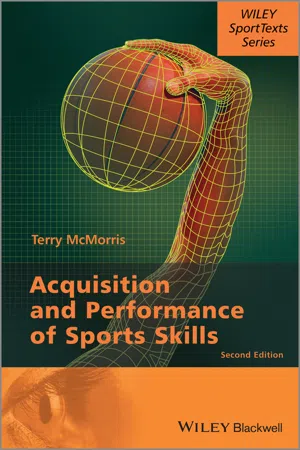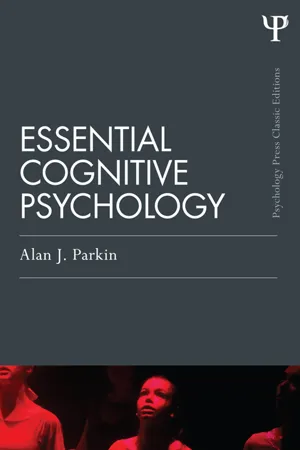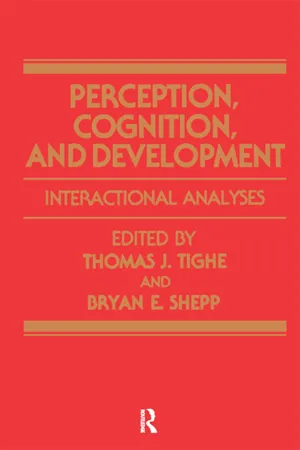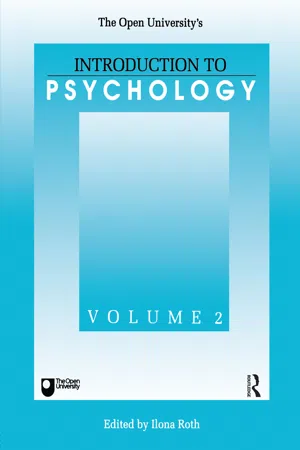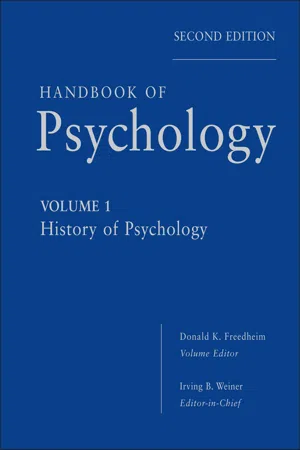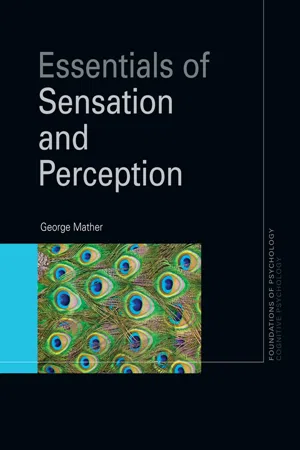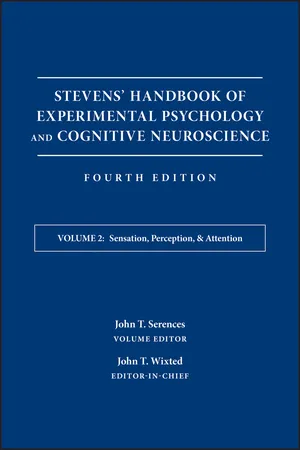Psychology
Sensory and Perceptual Processing
Sensory and perceptual processing refers to the way in which our sensory organs receive and interpret information from the environment. This includes the processes of seeing, hearing, touching, tasting, and smelling. Perceptual processing involves the brain's interpretation of this sensory information, leading to the formation of perceptions and experiences. These processes are fundamental to our understanding of the world around us.
Written by Perlego with AI-assistance
Related key terms
10 Key excerpts on "Sensory and Perceptual Processing"
- eBook - ePub
- Terry McMorris(Author)
- 2014(Publication Date)
- Wiley(Publisher)
2 Sensation and Perception of External InformationLearning objectives
At the end of this chapter, you should be able to:- understand what is meant by indirect or inferred perception
- describe how information processing theorists explain perception, with particular reference to:
- – signal detection theory
- – nature and role of selective attention
- – nature and role of visual search
- – how individual differences affect perception
- understand what is meant by direct perception
- have a basic knowledge of how ecological psychologists explain perception, including
- – nature and importance of affordances
- – how perception and action interact to detect affordances
- understand the main criticisms of information processing and ecological psychology theories with regard to perception
- be aware of the main developmental factors affecting perception.
In this chapter we examine, from an information processing perspective, how we perceive external information particularly for the purposes of making decisions. From an ecological psychology stand point, we are looking at how perception and action combine to recognize the existence of affordances in the environment. The role of perception in the control of movement is covered in Chapter 6 .Information processing theory, sensation and perception
Although information processing theorists argue that sensation and perception are different, the two concepts tend to be treated as one. The senses, which are the most important in the perception of information for decision making, are visual and auditory receptors. Vision is generally considered to be the most important of the senses. Light rays enter the eye through the lens and are detected by the retina. The central portion of the eye, the fovea, is rich in nerve receptors, which allow it to extract detail from an object. The range of foveal or central vision depends on how the eye is focused. This is controlled by the ciliary muscles, which are on either side of the lens. The range is generally regarded as being between 2° and 5°. The vision outside of this range is referred to as peripheral vision. The receptors, here, are less dense and images are less distinct than those found in foveal vision. Although foveal and peripheral vision are commonly used terms, Trevarthen (1968) used the terms focal and ambient vision. Focal vision is identical to foveal vision, but ambient vision differs a little to peripheral vision. According to Trevarthen, ambient vision - eBook - ePub
- Alan J. Parkin(Author)
- 2013(Publication Date)
- Psychology Press(Publisher)
2 VISUAL PERCEPTIONWhen I was a student I remember attending a lecture about the human visual system. Midway through the lecture a visiting professor stood and walked to the podium. Addressing the speaker he said, ‘Look, I can see, I’ve walked up here, what more is there to know?’ This was a profoundly ignorant statement which totally failed to appreciate the scientific challenge posed by the study of perception—in this case the visual system. The things around us do not automatically indicate to us what they are; our perception of the world is built up by internal processes which operate on an initial input that is far removed from what our sense organs initially register. Vision, for example, begins with a two-dimensional image on the retina but ends up as a three-dimensional scene in which there is depth, colour, movement, and so on. Similarly, hearing begins with the mechanical stimulation of cochlear hair cells by sound waves but what we hear is sufficient to allow us to appreciate the complex sounds of continuous speech.How then do we perceive the world? The prevailing view is to consider the various forms of perception as instances of an information processing system. It is proposed that perception begins with various analyses of the initial sensation which become progressively more complex until a percept is formed. A percept is the internal representation derived from the initial pattern of stimulation and it is this that serves as the basis for subsequent identification processes, i.e. determining what an object looks like, sounds like, smells like, and so on.Forms of perceptual processWe have, as you all know, five senses—vision, hearing, touch, smell, and taste. Cognitive psychologists have been very uneven in the time they have devoted to the study of our senses. Most work has been carried out on our visual system because of the dominant role it plays in communication. Next comes hearing, followed by touch, smell, and taste. Research into hearing has been quite substantial owing to the need to understand speech perception but the other three senses have received relatively little attention. However, research into touch (often known as haptic perception) has received considerable impetus from its relevance to communication aids for the blind. Smell and taste, although subject to some investigation within cognitive psychology, have been of more interest to physiologists. In this book we will be primarily concerned with visual perception (this chapter) and with hearing in relation to speech perception (Chapter 10 - eBook - ePub
Perception, Cognition, and Development
Interactional Analyses
- T. J. Tighe, B. E. Shepp(Authors)
- 2019(Publication Date)
- Psychology Press(Publisher)
Most early perceptual theorists did not directly deal with perceptual development but this classical theory was, in fact, a theory of perceptual development in the sense that mature perception could not occur without sophisticated cognition. Taking the developmental implications of this classical empiricist theory seriously led to a number of paradoxes. One of these is how animals and little children, both with seemingly limited cognitive capacities, could have relatively good depth perception and perceptual constancy. Related to this was the fact that mentally retarded persons by and large also have good depth perception and constancy. A second paradox is the fact that adults often have a great deal of difficulty getting back to the basic sensations. They primarily experience the results of the cognitively processed sensations, that is, the percepts. This paradox appears again in modern information processing views. An amusing characterization of it is made by Neisser (1976) who presents a figure of the chain of processing that runs from the image through several stages of processing and more processing until finally consciousness is reached. The standard resolution has been, and is, an appeal to overlearning (now automatization) of the cognitive processing. This combined with contemporary views about the very brief storage of the sensory information explains why we, as adults, can’t recover the sensations on which the percepts are based. Although this resolution seems reasonable, the classical theory has never done well in resolving the first paradox of the perceptual precocity of cognitively naive organisms.Notwithstanding the paradoxes in applying this theory to development of perception, it is vital to know the basic sensory elements faced by the young child that become the building blocks of the cognitive process resulting in perception. From the perspective of the classical theory, in order to understand how a child comes to see depth from the two-dimensional display on his retina, in order to understand how a child comes to see a meaningful persistent object in the world when receiving essentially meaningless sensory stimulation, we have to know what the initial sensations are. This is one motivation for current application to children’s perception of very sophisticated types of stimulus analysis and sensory measurement.The other side of the answer to the question of the relation of perceptual and cognitive development takes perception as the primitive or primary process on which cognition is based. This is exemplified by Piaget’s cognitive theory (but not his theory of perception). According to his cognitive theory, perception is a very primitive process that at best informs more sophisticated, intellective processes and at worst misleads them. For example, the earliest, most primitive stage of cognitive development is the sensory motor stage in which the only thing an infant knows about an object is the way he or she interacts with it, initially simply reflexive interaction. Even at its height of development, perception is similar to preoperational thought (Flavell, 1963), and perception at best gives probabilistic and variable, rather than absolute, knowledge. If that is not bad enough, when faced with conservation tasks, the preoperational child is misled by her perception and has a terrible time realizing that one has to overrule the perceptual appearance of something with a cognitive rule about whether something has been added or subtracted. Perception can become more veridical through perceptual activity that overcomes distortion attributable to fixation on restricted aspects of a stimulus. While lack of conservation (e.g., of volume) may be attributable to fixation of perception on the dimension of height, say, in detriment to registering both the height and width of a column of fluid, one resolution of this error is the perception - eBook - ePub
- Ilona Roth(Author)
- 2020(Publication Date)
- Psychology Press(Publisher)
These are deep and difficult issues. Psychologists certainly do not claim that all the physiological and psychological theories of perception add up to a complete explanation of the complex interaction between knowledge and perceptual experience. We exploit our perceptions to gain experience and knowledge about the world. We use current expectations to explain apparent contradictions in the environment. At the same time, we have to pay attention to what is actually happening. Survival would be difficult if animals moved around in a haze of top-down expectations, without the ability to react instantaneously and directly to bottom-up stimulation of sensory receptors. It is not at all easy to strike the right balance between representations of prior knowledge and the analysis of sensory inputs by sensory systems. Perception can be thought of as a ‘conflation of what one remembers and what one sees’. This is indeed a crucial issue both for perceivers in general and for psychologists who study perception, although, as perceivers ourselves, it normally causes us very little bother.Summary of Section 6
- According to feature detection models, feature detectors operate in a bottom-up direction, analysing sensory inputs and combining them at higher levels.
- Perceptual hypotheses and perceptual models involve the testing of hypotheses based on past experiences against sensory cues, incorporating both top-down and bottom-up processing.
- Gibson’s theory of direct perception emphasizes the total array of light stimulation which he claims is sufficient for perceptual interactions with the environment, without the need for intermediate processing stages.
- Basic sensory processes like depth perception are innate in most species and develop at a very early stage of infancy in humans. Without some basic perceptual mechanisms, human infants would not have the equipment necessary to learn about the environment.
- Evidence from the restoration of sight to people born blind indicates that some learning is required for fully effective perception.
- For perception to provide a basis for adaptable behaviour in humans, there needs to be an interaction between analysis of sensory information and interpretations based on learned knowledge and expectations about the environment.
I would like to thank Ilona Roth and John Pickering whose work in an earlier Open University psychology course has been helpful in the writing of this chapter.Personal acknowledgements
Further reading
- Gregory , R. L. (1972) Eye and brain
- eBook - ePub
- (Author)
- 2012(Publication Date)
- Wiley(Publisher)
Fortunately, a broad overview shows that it is possible to see some unifying perspectives that have evolved through the history of the study of perception and are not bound to any single sensory modality. This seems to have been recognized by many researchers in this area, since it is not uncommon for them to do research on several sensory systems at the same time. Thus, we find Helmholtz and Hering studying both vision and audition, and Georg von Békésy, who won the Nobel Prize for his work on hearing, also did research on vision and touch. When it comes to theorists, Fechner, Stevens, Ames, Gibson, Wertheimer, Koffka, Helson, and others have presented frameworks, models, and mechanisms that are virtually modality independent, and can be tested and applied to vision, hearing, or any other sensory system. This is not to deny that there are issues that are important to particular single sensory modalities that do not generalize. For example, the chain of events that leads from the absorption of a photon to a visual neural response and ultimately to a conscious recognition of the stimulus seems to be unique to vision. Instead, I am suggesting that there are global theoretical and methodological frameworks that encompass all sensory and perceptual research. To refer back to that very specific issue of visual detection, while the mechanism of how a photon is captured is specific to sight, all sensory modalities must deal with the idea of detection, which includes the idea of sensory thresholds and their relationship to what the individual consciously perceives. It is also likely that the higher level decisional processes, where the observer must decide if a stimulus is there or not, will be the same whether one is dealing with vision, audition, olfaction, or any other sensory system. Thus, we find that there are certain common issues and definitions that cut across all sensory modalities. These methods, philosophical foundations, and psychological understandings have undergone a steady evolution during the history of this area of psychological research.This chapter is written as an overview and concentrates on some general themes, rather than on the data and findings from any one sensory modality. From this, hopefully, some idea of the context and scope of the study of perception, and its relationship to other aspects of psychology and other sciences, will emerge. Three global issues will reappear many times and in several guises during this history. The first deals with the perceptual problem, which is really the issue of the correspondence (or noncorrespondence) between our internal representation of the environment in consciousness and the objectively measured external physical situation. The second has to do with the borrowing of methods, viewpoints, and theoretical formulations from other sciences, such as physics and physiology. The third is the distinction between sensation and perception, which is really the distinction between stimulus-determined aspects of conscious and interpretive or information-processing contributions to the conscious perceptual experience.The Perceptual Problem
We must begin our discussion with some philosophical considerations. This is not merely because all of science began as philosophy, nor because up until the middle of the 20th century, philosophy and psychology departments were often combined as the same academic entity in many universities. The reason that we begin with philosophy is because it takes a shift in philosophical viewpoint to justify why we need a psychological discipline to study sensation and perception in the first place. Most people have a naïve, realistic faith in the ability of our senses to convey an accurate picture of the world to us. For the proverbial “man on the street,” there is no perceptual problem. You open your eyes and the world is there. According to this viewpoint, we perceive things the way that we do because that is the way that they are. We see something as a triangular shape because it is triangular. We feel roughness through our sense of touch because the surface is rough. Thomas Reid, a Scottish philosopher who will later prove to be very significant in the history of perception, summarized this idea in 1785 when he wrote: - eBook - ePub
- Joan T. Erber(Author)
- 2019(Publication Date)
- Wiley-Blackwell(Publisher)
For this purpose, we depend upon our eyes, ears, nose, and other sensory organs, through which we experience our initial contact with stimulus events and objects in our environment. Our senses include taste, smell, touch, vision, hearing, as well as a sixth sense that includes proprioception. Researchers who study aging have noted the importance of sensory processes; according to the common cause hypothesis, the link between sensory processes and cognitive functioning becomes stronger in older adulthood than it was earlier in life (Baltes & Lindenberger, 1997). Although age-related differences in cognitive functioning may not be fully explained by sensory declines (Anstey, Luszcz, & Sanchez, 2001; Lindenberger, Scherer, & Baltes, 2001), there is little question that having good sensory capabilities is related to good memory and verbal abilities (Schneider & Pichora-Fuller, 2000; Wingfield, Tun, & McCoy, 2005). Also, good sensory capabilities, particularly vision and hearing, are associated with the ability to perform self-care activities (e.g., bathing, dressing, and grooming), to do household chores and go shopping (Marsiske, Klumb, & Baltes, 1997), and to take part in social activities. Once the sensory organs register it, information can be passed along to the central nervous system for higher-level, perceptual processing, which entails interpreting what the information means and making decisions about how to respond. Often, there is more information in our environment than we can possibly register, let alone process, at any given time. Attention has to do with exactly what information we will process from the large array of stimuli that impinge upon our senses. Threshold and Sensitivity Sensory organs need a certain intensity of stimulation before they register the presence of a signal, or stimulus. The term threshold refers to the minimum amount of stimulation a sensory organ must receive before the presence of a particular stimulus is registered - eBook - ePub
The Highly Sensitive Brain
Research, Assessment, and Treatment of Sensory Processing Sensitivity
- Bianca P. Acevedo(Author)
- 2020(Publication Date)
- Academic Press(Publisher)
Chapter 3Sensory processing sensitivity—For better or for worse? Theory, evidence, and societal implications
Corina U. Grevena , b , c ; Judith R. Hombergaa Department of Cognitive Neuroscience, Donders Institute for Brain, Cognition and Behaviour, Radboud University Medical Center, Nijmegen, The Netherlandsb Karakter Child and Adolescent Psychiatry University Center, Nijmegen, The Netherlandsc Social, Genetic & Developmental Psychiatry Centre, Institute of Psychiatry, Psychology & Neuroscience, King’s College London, London, United KingdomAbstract
Human behavior is fundamentally context-dependent. Humans (and other species) are sensitive to environmental influences to varying degrees with those with high sensory processing sensitivity (SPS) being exceptionally sensitive to the environment. In this chapter, we review several frameworks on heightened sensitivity to the environment, including diathesis-stress, biological sensitivity to context, differential susceptibility, vantage sensitivity, SPS theory, and the environmental sensitivity metaframework. We then place SPS in the context of these frameworks to elucidate how they inform SPS theory. Next, we present empirical evidence showing that SPS is indeed linked to greater sensitivity to negative and positive environments. We conclude by discussing implications of SPS for general public health and practical applications for building a diversity-aware society. - eBook - ePub
- Irving B. Weiner, Alice F. Healy, Robert W. Proctor(Authors)
- 2012(Publication Date)
- Wiley(Publisher)
psychophysics, which offers indispensable tools for the researcher. Here we lead the reader from the idea of threshold to the tools of signal detection theory. To illustrate our presentation of methodology, we have not focused on the classics that appear in much of the secondary literature. Rather, we have chosen recent research that showcases the current practice in the field, and the applicability of these methods to a wide range of problems.The contemporary view of perception maintains that perceptual theory requires an understanding of our environment as well as the perceiver. That is why, in the third section, we ask what are the regularities of the environment, how may they be discovered, and to what extent do perceivers use them. Here, too, we use recent research to exemplify this approach.Reviews of the research on higher visual processes are available in Tse and Palmer, this volume, and by Proffitt and Caudek, this volume.Theories and Foundational Questions
Theories
Four theoretical approaches have dominated psychology of perception in the 20th century: cognitive constructivism, Gestalt theory, ecological realism, and computational constructivism.Cognitive Constructivism
According to cognitive constructivism, perceptual processing involves inductive inference or intelligent problem solving. Perceptual processing operates beyond one's awareness, and attempts to construct the best description of the situation by combining the facts of occurrent stimulation with general and context-specific knowledge. These cognitive processes are not thought to be specially designed for the problems of perception; they are the same cognitive operations that are at work in conscious inference and problem solving. Accordingly, the nature and effects of these cognitive operations may be profitably studied in any setting that activates them. It is neither necessary nor desirable to reinstate the typical conditions of ordinary seeing.Cognitive constructivism has a venerable tradition. Traces may be found in Kepler's 2000 writings and in vigorous criticism of the approach in Berkeley's An Essay Towards a New Theory of Vision (1732/2000). Among 19th century writers, cognitive constructivism is famously associated with Helmholtz's 2000 doctrine of unconscious inference as expressed, for example, in his Treatise on Physiological Optics - eBook - ePub
- George Mather(Author)
- 2014(Publication Date)
- Routledge(Publisher)
Figure 5.5 contains a general functional diagram of perceptual processing, which makes the role of representation explicit. Each box corresponds to a separate stage of processing, and arrows represent the flow of information between one stage and another. Each stage can be identified with a specific population of neurons in the nervous system. As you saw in previous chapters, the different senses generally conform to this kind of processing scheme. After one or more synapses in the sense organ, signals travel along afferent fibers toward the thalamus. Neurons in the thalamus then send the signals to primary sensory cortex, from where they travel on to secondary cortical areas. Information also flows down from the cortex to the thalamus. The information that is passed from one stage to the next contains a representation of some aspect of the outside world. Responses in gustatory fibers, for example, carry information that represents the sugar, salt, acid, plant alkaloid, and amino acid content of the substance currently sitting on the tongue. So any one stage of processing, any box in the diagram, receives a representation as input and produces a representation as an output. What happens inside each box?Computation in perception.Figure 5.5 Representation and computation during hierarchical sensory processing. Each box corresponds to a population of neurons that receive an input representation from the previous stage of processing and compute an output representation for transmission to the next stage of processingEach box in Figure 5.5 must transform its input in some way to create an output representation. This transformation is accomplished by the neurons that implement that stage of processing. You can describe the operation physiologically in terms of interactions between neurons, inhibition, excitation, and so on, or in more abstract mathematical terms. A good example is offered by neurons with center–surround receptive fields described in Chapter 2 (p. 30) and illustrated in Figures 2.3 and 2.7 . They receive a pattern of activity from a group of receptors, either mechanoreceptors in the skin (Figure 2.3 ) that respond to mechanical distortion, or photoreceptors in the retina (Figure 2.7 - (Author)
- 2018(Publication Date)
- Wiley(Publisher)
When most individuals think of the psychological study of learning, the types of exemplars that spring most naturally to mind are often academic in nature, such as the learning of state capitals or of basic mathematical algorithms. A smaller subset of individuals might envision more procedural forms of motor learning, such as learning to ride a bicycle or learning to throw a baseball. What is rarely considered, though, is perceptual learning. Although we may remember struggling to learn certain scholastic material, we never seem to recall struggling to learn to categorize objects by their visual properties or to properly segment a speech stream in our native language. Instead, we tend to largely take our perceptual skills for granted. Our seemingly infinite perceptual fluency in areas as diverse as object recognition and speech recognition is considered a simple matter of course, rather than something that has been slowly developed over time via experience. Furthermore, we also do not consider the fact that many of our deficiencies, such as our inability to effectively individuate the faces of races other than our own, or to detect the presence of phonemes that are not part of our native language, are similarly driven via experience. Although the perceptual system is not totally naïve at birth (there is some structure built in via, for instance, patterns of coordinated neural activity that occurs in utero), it is nonetheless incredibly receptive to reorganization based upon the set of environmental statistics under which an individual finds himself/herself living (Espinosa & Stryker, 2012). After all, there is simply no way to build in a perceptual system that performs equally well in a dense, visually crowded, low‐light jungle environment and in a sparse, high‐light desert environment (and all the environments in between). Instead, in order for humans to thrive across the myriad perceptual environments on earth, it is essential that our perceptual systems be highly adaptive and responsive to the perceptual demands that each individual encounters.This adaptivity not only supports performance on basic perceptual and perceptuo‐motor tasks, but our learned perceptual abilities also underlie behavior in many higher‐level functions. Indeed, the “front end” of many higher‐level cognitive functions and domains of expertise are the perceptual systems. Reading is one particularly excellent example of an activity that is clearly reliant upon, and constrained by, our perceptual systems. For example, reading is partially limited by the resolution of our peripheral vision as most of the letters we read are not individually fixated (Yu, Legge, Wagoner, & Chung, 2014). It is also an activity for which our visual abilities change in such a way so as to facilitate the activity. Thus, readers of languages, such as English, that are read left to right more easily recognize words to the right of fixation as compared to readers of languages, such as Hebrew, that are read right to left (Kazandjian, Cavezian, Zivotofsky, & Chokron, 2010).Here we review the broad domain of perceptual learning. We first start with a surprisingly difficult question—what is perceptual learning? We then discuss how perceptual learning is studied and the types of abilities that have been shown to be enhanced via perceptual learning. We then consider current mechanistic and neural models of perceptual learning and how they match up with the empirical data, in particular, in terms of how well they predict the specificity/generality of learning effects. Finally, we review possible practical applications of perceptual learning and future directions for the field.
Learn about this page
Index pages curate the most relevant extracts from our library of academic textbooks. They’ve been created using an in-house natural language model (NLM), each adding context and meaning to key research topics.
